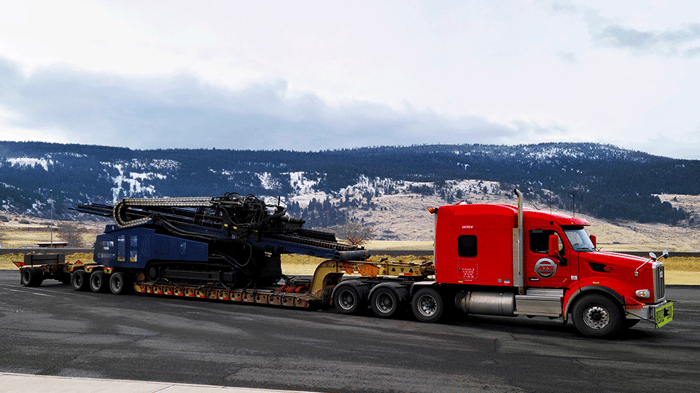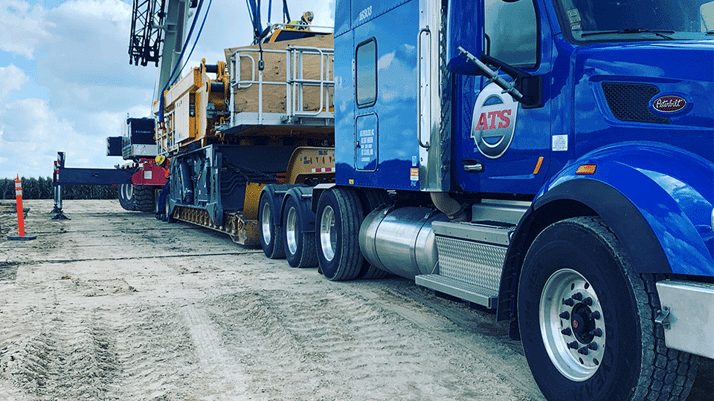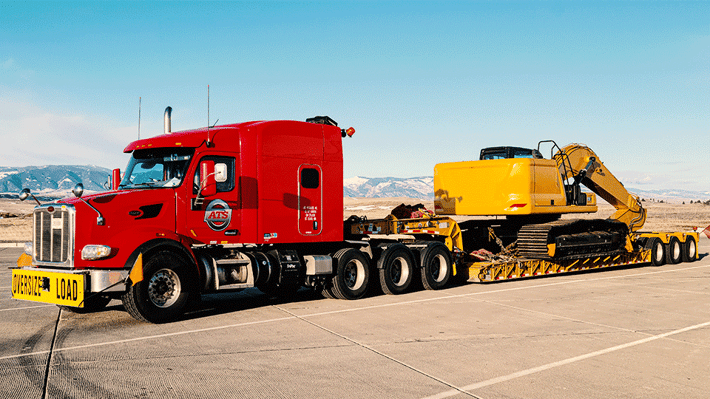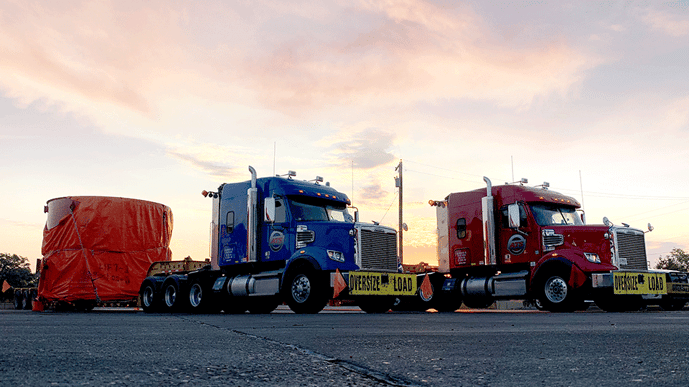If you have questions about whether your freight will need heavy haul trucking service, you’re not alone. The transportation industry, and the companies within it, offer an array of services meant to meet the needs of businesses across industries.
However, due to ambiguous, inconsistent definitions of what kind of cargo (dimensions, weight, commodity type, etc.) each solution fits, sometimes companies have trouble selecting a service for theirs — especially at a glance.
Here at Anderson Trucking Service (ATS), we’re constantly asked about what the term “heavy haul” means. Over the years, we’ve taken pride in comprehensively answering these queries when they arise and pointing shippers toward their best-fit transportation solution.
In this article, we’ve outlined what truly makes a shipment “heavy haul” — a definition that tends to change from one carrier to the next — so you can feel confident in your transportation decisions.
When it comes to the movement of your freight, confusion as to what service type it needs puts you at a disadvantage; leaving you singularly reliant on the input of the carriers you use.
In the interest of gaining more control, monetarily and otherwise, it’s important to do your research. Today, let’s do just that.
Below, you’ll find high-level heavy haul trucking information including:
- What are heavy haul freight dimensions?
- What commodity weight is considered heavy haul?
- What trailers are used for heavy haul trucking?
- What makes heavy haul trucking so different?
- What does heavy haul shipping cost?
What Are Heavy Haul Freight Dimensions?
Typically, heavy haul trucking service will need to be arranged for shipments that exceed any or all of the following loaded dimensions: 14 feet, 6 inches high; 14 feet, 6 inches wide; 100 feet long. Additionally, any load with a single extreme dimension (i.e., more than 16 feet across or tall) will require heavy haul trucking service.
Note: Heavy haul freight dimensions change between carriers; these are the dimensions used to categorize “heavy haul” at ATS. Though these dimensions should accurately depict those defined by other carriers, it’s important to ask your provider about your specific shipment.
What Commodity Weight Is Considered Heavy Haul?
Any load that has an overall piece weight in excess of 55,000 pounds is considered a heavy haul shipment.
Additional truck and trailer axles are needed to safely haul cargo that exceeds 55,000 pounds, categorizing these shipments as “heavy haul.”

What Trailers Are Used For Heavy Haul Trucking?
Heavy haul shipments, in excess of the dimension and weight thresholds listed above, require some of the most specialized trailers the transportation industry has to offer.
For heavy haul shipments that exceed 14 feet, 6 inches tall, 14 feet, 6 inches wide and/or 100 feet long, but not 55,000 pounds adding axles isn’t always necessary. Here are some common trailers used in these scenarios:
- Removable gooseneck trailers (RGNs)
- Extendable RGNs
- Flatbed, step-deck and double-drop trailers
- Extendable flatbed trailers
- Lowboy trailers with outriggers
As a heavy haul load’s overall weight rises, the composition of the trailer used to haul it will change. To further distribute weight, additional axles need to be used.
By and large, as soon as your commodity weight exceeds 50,000 pounds, you’ll need no less than six total axles to haul it. The majority of shipments — those of legal weight — utilize five total axles (1 steer, 2 drive, 2-3 trailer).
Using a three-axle trailer (RGN, step-deck, etc.) as well as a heavy haul 4-axle semi-tractor, is more than an adequate solution for “heavy haul” shipments up to 85,000 pounds.
Heavy haul loads beyond this point, will require additional axles that will include jeeps and stingers to ensure weight is distributed correctly.
What is a Heavy Haul Tractor?
A standard heavy haul tractor is a four-axle semi-truck (1 steer, 1 pusher, 2 drives), specially designed to haul extremely heavy loads. These tractors are double framed with a 20,000-pound front axle and much larger steer tires.
Usually, heavy haul tractors are used in conjunction with trailers that exceed two axles, giving carriers the seven (or more) total axles needed to transport heavy cargo.

How Many Axles Are Needed For Heavy Haul and How Are Axles Added?
Once the total cargo weight of a shipment exceeds 65,000 pounds, a 7-axle setup is typically necessary. Getting these seven axles can be done in a number of ways. Usually, however, carriers will use a 4-axle heavy haul truck and a 3-axle trailer — which can be a flatbed, step-deck, or RGN.
From here, handling shipments exceeding 7-axle weight thresholds is often done by adding jeep and/or stingers — legal axle weight limits vary by location, but this typically happens at around 85,000 pounds.
While there are 4-axle trailers (called “closed quads”), jeeps and stingers are commonly used to achieve the eight, nine and 10+ axles necessary for the heaviest moves.
Check out this article, Heavy Haul Trucking: How Does Freight Weight Impact Trailer Type? for a more in-depth overview of heavy haul trailer combinations.
What Makes Heavy Haul Trucking So Different?
Now that you understand the thresholds at which your shipments will need heavy haul service and the kind of equipment that’s typically used here, you’re likely wondering why carriers even bother classifying heavy haul trucking differently than other transportation services.
Wouldn’t it be easier to simply lump heavy haul loads in with other open-deck shipments, adjust the number of axles or trailer type needed and move on?
Realistically, however, the intricacies of heavy haul shipping extend beyond the equipment needed to physically move products. You see, in order to direct these shipments without a hitch, heavy haul transportation providers must also be highly skilled in other areas.
Among other things, heavy haul freight moves necessitate that:
- Drivers have the correct experience and training
- Route planning and route surveys happen
- The appropriate permits are acquired
- The necessary safety services are contracted
To give you a better understanding, let’s talk a bit about each of these complexities that are exclusive to heavy-haul trucking.
Drivers Must Have The Correct Experience and Training
Heavy haul trucking is an incredibly dangerous enterprise. Hauling shipments that exceed legal thresholds can be challenging as every curve, stop, lane change and turn must be negotiated appropriately.
Without experience hauling oversized and overweight loads, truck drivers may inadvertently put themselves and the motoring public in harm's way. For this reason, trucking companies are highly vigilant about which drivers they allow to haul these shipments. Only drivers with the proper training and tenure — during which time they’ve progressively advanced their skills — are given these responsibilities.
Beyond this, heavy haul drivers also have to deal with the realities of moving such large freight.
These drivers must have the ability to stick to their designated route (the route that freight has been permitted to travel), manage their hours of service appropriately, plan out where they will stop for the night and be highly vigilant of local travel rules/restrictions.
Route Planning and Route Surveys Must Happen
The route of your heavy haul freight is important for a number of reasons — a fact that’s not lost on great heavy haul carriers.
First of all, since heavy haul cargo must be permitted — and permit prices shift between locations — the cost of moving it from A to B will change based on its route. As such, to move heavy haul freight as cost-effectively as possible, planning its route pre-emptively is a must.

Additionally, the largest heavy haul shipments simply can’t traverse every roadway. Things like bridges, overpasses and powerlines (to name a few) can prevent these loads from continuing onward — throwing off an ill-planned shipment.
A heavy haul shipment’s route is surveyed when either the state or the carrier decides that, at certain dimensions, it’s in their best interest (from a safety standpoint) to do so prior to movement. That said, planning the route of these loads takes an experienced carrier with plenty of resources and relationships to get right.
Learn more about The Intricacies of Route Planning in Oversized Shipping here
The Appropriate Permits Must Be Acquired
Every mile a heavy haul load travels requires that shipment to be properly permitted. Over-dimensional/overweight permits are distributed at the state, county and municipal levels. As a result, multiple permits are necessary for heavy haul transport.
In the end, heavy haul loads with permitting requirements run into issues without a sure-handed provider and proper planning; getting permits takes time and partnerships with various entities.
That said, when legally necessary, non-divisible heavy haul shipments must be permitted without exception.
Related: How to Get Oversized Load Permits For Your Freight
The Necessary Safety Services Must Be Contracted
To get heavy freight from A to B as safely as possible, trucking companies may have to work with several external safety services throughout this process.
This may include things like route survey providers, pilot car services, utility professionals (to move powerlines, signs, etc.), police escorts and engineering firms (to evaluate roadways).
Trucking companies must take whatever steps necessary to safely and securely move heavy haul products, working with the correct safety service providers is a crucial piece of this.
What Does Heavy Haul Shipping Cost?
Like many other transportation services, heavy haul trucking costs fluctuate greatly from one scenario to the next. For this reason, it’s difficult to generalize what your specific shipment will cost.
Realistically, you should expect your heavy haul shipment to cost between $5 and $10 per mile plus fuel. Still, this is a huge range.
 In some instances — when a load is less than 100,000 pounds — it’s possible to estimate its heavy haul price by multiplying $1 by the number of total axles needed times its length of haul.
In some instances — when a load is less than 100,000 pounds — it’s possible to estimate its heavy haul price by multiplying $1 by the number of total axles needed times its length of haul.
So, with this formula, a 65,000-pound 7-axle shipment traveling 600 miles would cost around $4,200.
This method for finding your price becomes less effective as your shipment’s overall weight arches beyond 100,000 pounds — making it imperative to understand how your freight rates are actually calculated. . .
Looking for a comprehensive breakdown of the factors impacting your comprehensive freight rates?
Read the article What Does Heavy Haul Trucking Cost? for this information.
Looking To Ship a Heavy Haul Load? Here’s Your Next Step
As you now understand, heavy haul transportation is not a simple process. With so many intricacies to plan for and variables to consider, this service simply can’t be offered by every carrier.
Safely and efficiently moving these goods is a skill learned over time. And, using an unreliable, unsafe carrier could do significant damage to your supply chain and relationships.
That said, with so many heavy haul carriers to choose from, it can be difficult to select the best ones from the field.
To help you do so, we developed this Heavy Haul Carrier Selection Checklist.
Download it for free today and ensure that the trucking company you trust with your next load has the ability to move it safely and securely.
Finally, here at Anderson Trucking Service, we take pride in offering industry-leading heavy haul trucking solutions catered to the unique needs of each shipper.
So, if you have questions about how ATS can help you move your next shipment or what starting a partnership with us could mean for you, contact us today. We’re always happy to help you in any way you need!




